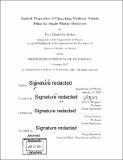| dc.contributor.advisor | Karl K. Berggren and Vladan Vuletic. | en_US |
| dc.contributor.author | Archer, Lucy Elizabeth | en_US |
| dc.contributor.other | Massachusetts Institute of Technology. Department of Physics. | en_US |
| dc.date.accessioned | 2017-10-30T15:29:02Z | |
| dc.date.available | 2017-10-30T15:29:02Z | |
| dc.date.copyright | 2017 | en_US |
| dc.date.issued | 2017 | en_US |
| dc.identifier.uri | http://hdl.handle.net/1721.1/112044 | |
| dc.description | Thesis: S.M., Massachusetts Institute of Technology, Department of Physics, 2017. | en_US |
| dc.description | Cataloged from PDF version of thesis. | en_US |
| dc.description | Includes bibliographical references (pages 75-78). | en_US |
| dc.description.abstract | In this thesis I made a study of the properties of reactively sputtered ultra-thin films of niobium nitride (NbN) and niobium titanium nitride (NbTiN). Using Variable Angle Spectral Ellipsometry (VASE), I found that the optical properties of NbN films appear to have a critical thickness above which the optical parameters stabilize. I also found that the deposition process has better stability over time for thicker films than for thinner ones; that is, when films are deposited weeks apart, the thinner films show more variation in thickness and optical properties than do the thicker films. The data also suggest that the crystallinity of the substrate upon which the NbN is deposited has a significant effect on the optical parameters. The set of films deposited for the optical study was also tested against a universal scaling law for thin film superconductors, which seems to support the existence of the critical thickness, below which the properties change significantly and do not conform to the power law scaling that holds for thicker films. Finally, I explored recipes for depositing NbTiN with our sputtering system, in the hope of creating films that have better properties than NbN to be used in device manufacturing. I was able to create films with the same properties as our current NbN films with minimal optimization, and further work in this area should result in NbTiN films that are better than our NbN films. | en_US |
| dc.description.statementofresponsibility | by Lucy Elizabeth Archer. | en_US |
| dc.format.extent | 78 pages | en_US |
| dc.language.iso | eng | en_US |
| dc.publisher | Massachusetts Institute of Technology | en_US |
| dc.rights | MIT theses are protected by copyright. They may be viewed, downloaded, or printed from this source but further reproduction or distribution in any format is prohibited without written permission. | en_US |
| dc.rights.uri | http://dspace.mit.edu/handle/1721.1/7582 | en_US |
| dc.subject | Physics. | en_US |
| dc.title | Optical properties of ultra-thin niobium nitride films for single photon detectors | en_US |
| dc.title.alternative | Optical properties of ultra-thin NbN films for single photon detectors | en_US |
| dc.type | Thesis | en_US |
| dc.description.degree | S.M. | en_US |
| dc.contributor.department | Massachusetts Institute of Technology. Department of Physics | |
| dc.identifier.oclc | 1006428014 | en_US |
